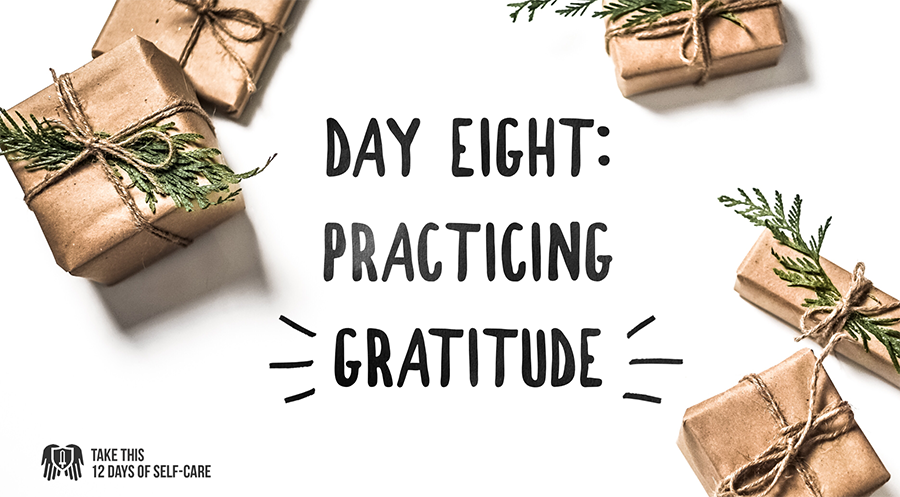
On the eighth day of our 12 Days of Self-Care series, Dr. Megan Connell teaches us the techniques involved in practicing gratitude. For more helpful tips on coping with common stresses of the holiday season and the transition into the new year, check back every day.
Tis’ the season when we are inundated with commercials showing us the newest, shiniest gifts, from new cars with oversized bows on them to expensive TVs and other gadgets. These ads are designed to get us to look at what we have and think, “this isn’t enough, this isn’t making me happy.” The problem is that things don’t make us happy. Things can increase our pleasure for a time, but our brains will quickly habituate. What was shiny and new becomes the old and mundane. If we aren’t careful, we can get caught up in a never-ending consumer quest to find the one thing that will make us happy. How do you avoid this trap of desire? One simple method is to practice gratitude.
Gratitude is the art of being thankful for what you have. Practicing gratitude is not something that comes easily or naturally. Our brains are designed for survival, and part of surviving is ensuring we have what we need. Fixating on what we don’t have is our brain’s way of keeping us focused on that goal. One of the problems that we face in the modern world is that often, we fixate on things that we don’t need for survival. So, while our brain might be fixated on a 4k gaming monitor, we do not need that to survive (well, I mean, it might up the chances of my avatar surviving…). Gratitude is a helpful way to allow our brain to re-focus on what we do have, and encourage it to appreciate what is around us.
How to practice gratitude
To practice gratitude, try to find three or four things around you that you can be grateful for. It helps if those things are either needed for survival or make survival much easier. For example, being grateful for having a safe place to sleep, joints that don’t hurt, shoes that fit, a thermostat that regulates temperature, food to eat, clean water to drink, hot water to wash in, glasses that correct your vision, good books to read, and so on.
When you’re practicing gratitude, take a moment to imagine your life without the thing you are grateful for. For an example, if you’re grateful about your feet, you could think about how many steps you have taken that day, all the places you have been able to go because you could walk easily. If you have had a bad cold this season and don’t any longer, take a moment to take a deep breath and recall how difficult that was to do when you were ill. Reflect on how nice it is to breath without coughing or having congestion. Or even to focus on modern convinces, such as cars that allow us to live more than five miles from where we work, and enable us to quickly and (relatively) safely travel hundreds of miles in a single day.
When you practice gratitude, do so several times a day. Try to find three things you can be grateful for every two to three hours. The more you intentionally practice gratitude the more natural it becomes for your brain to shift to noticing the things you do have than fixating on what you do not have.
Remember; keep up the practice! As it is our brain’s natural tendency to habituate to the good and focus on what we do not have, you have to be intentional about your practice of gratitude. Also, as a bonus, try being grateful for the people around you. Let the people you are grateful for know that you feel that way. Sometimes, being told what you mean to someone can mean more than any gaming monitor or gadget.
Dr. Megan Connell is a psychologist with Southeast Psych in Charlotte NC. She served for six years in the US Army to include a deployment to Iraq. She is the Co-founder of Geeks Like Us, a geek community focused on empowerment, entertainment, networking, and research. She can also be found monthly on www.twitch.tv/G33ksLikeUs where she is the DM for Clinical Roll, a D&D game where all of the players are geek therapists. You can follow her @MeganPsyD on Twitter.
This article is not a substitute for medical advice or professional counseling. While we at Take This want to provide you with resources, we do not recommend or endorse any particular site, treatment, therapy, or resource. We provide these links at our sole discretion but have not necessarily vetted or reviewed any particular resource. We assume no liability for the use of the information or resources on these sites and encourage you to use your own best judgment when reviewing these resources.
If you live in the US and you’re having suicidal thoughts, reach out to the Suicide & Crisis Lifeline or call/text 988. If you’re outside the US, you can find local crisis lines at Suicide.org. If you’re even debating whether you should call them, you should call them. The Suicide & Crisis Lifeline handles all psychological crises, not just suicide.
